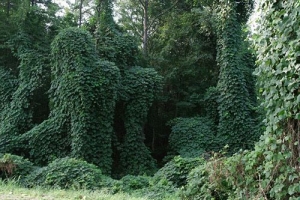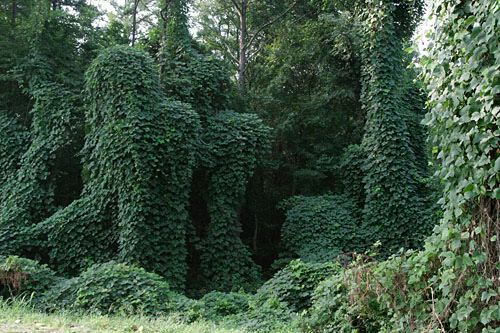
Kudzu – Friend or Foe?
Do you remember the movie ‘The Blob’? It was first released in 1958 and starred Steve McQueen and his girlfriend Jane (Aneta Corseaut). The movie was about a gelatinous, alien life form that slowly engulfed everything in its path. I think that this is how most of us view kudzu. It just looks like a scary, green monster that slowly creeps along and devours everything it touches. It also looks as if snakes, thick as spaghetti noodles, would be living in the kudzu patch just waiting for some unsuspecting critter/person to wander too close. Well, some of that is true and some is not.
The other day I was showing a beautiful tract of land to a client of mine. The showing was going well until we came around a corner and yep, there it was. A huge old scary-looking kudzu patch. My client asked me…What do you do about that? I told him that I was not exactly sure but that I would do a little research and get back to him. What I found was really interesting…
History of kudzu in the US – It turns out that kudzu was first introduced to the US from Japan at the World’s Fair in Philadelphia, in 1876 as a way to control soil erosion. It was later introduced in the Southeast in 1883 as, get this…a beautiful ornamental plant that would provide shade for porches during the hot summers that we experience here in the Deep South! Other uses included livestock feed, fertilizer, erosion control, honey, and as a potential source for biofuel. In the Pacific Rim they use the kudzu root in cooking, teas, and herbal remedies.
At one time the government was actually paying folks to plant kudzu. In 1953 the US Department of Agriculture removed kudzu from a list of suggested cover plants and in 1997 kudzu made the “Federal Noxious Weed List”.
Spread of kudzu – estimates vary widely on just how many acres are being consumed by kudzu in the south. One estimate claims that in 1946 about 3,000,000 acres of kudzu had been planted and that today there are about 7,400,000 acres covered by kudzu, primarily in Alabama, Mississippi, Georgia, Tennessee, and Florida. However, recent information from the US Forest Service indicates that only about 227,000 acres have kudzu growing on them.
Characteristics of kudzu – Kudzu is a very stress tolerant plant. Kudzu is also drought tolerant and thrives in climates like we have in the Southeast. The growing season for kudzu is May-October and the plant, once established can grow about a foot per day. If left unchecked the kudzu literally climbs up on shrubs and trees and, just like ‘The Blob’, engulfs them so that the sun’s rays are blocked and all photosynthetic productivity is either diminished or completely eliminated.
Economic Impact – Lost forest productivity is estimated at around $300,000,000.00 per year. It is also estimated that power companies spend about $1,500,000.00 – $1,700,000.00/year to repair damage to power lines caused by kudzu. Also the national parks in the Southeast are battling this nuisance.
Control of kudzu – The good news is that with money and effort kudzu can be controlled. The most common ways of controlling kudzu are: 1) Mechanical…This involves mowing or cutting the vine back to just above ground level. All of the kudzu debris should be removed and burned to prevent it from re-growing. You can also remove the root crown. You can use a shovel to expose the base of the root crown and then use an axe to severe the root below the root crown. 2) Herbicides…Tordon and Triclopyr are common herbicides used to treat kudzu. When using herbicides it is best to apply them once at the beginning of the growing season and again late summer or early fall. To completely kill the plant you need to plan on spraying 40-80 gallons/acre and it could take a few years of treating to eradicate the plant. 3) Animal grazing also can help in the battle. I have heard of people deploying a small herd for goats or sheep to graze on the kudzu.
Summary – It just goes to show you that something that started way back in 1876 as a good idea to control soil erosion actually has turned out to be a nuisance at best, and ‘The Blob’ at worst.
So what did I tell my client that asked “What do you do about that”? While kudzu is considered a negative to most, it can be controlled and killed. So if you are a landowner and you have kudzu growing on your property I would get with your county extension office and come up with a plan of attack now. And if you are looking to become a landowner, I would not automatically dismiss a property just because it has kudzu growing on it. I would estimate the cost and time that it would take to control the kudzu and factor that into my offer.
So is Kudzu a friend or foe? I am going to have to say a little of both. It did help with controlling soil erosion, but it is a nuisance that we here in the south are just going to have to continue to deal with.
Eric Leisy
I would love to hear your kudzu stories! Please email them to me at Eric@GreatSouthernLand.com
